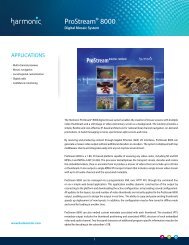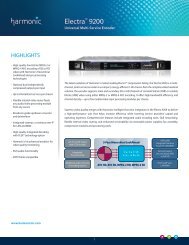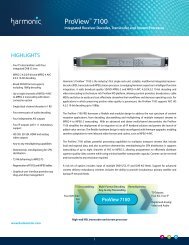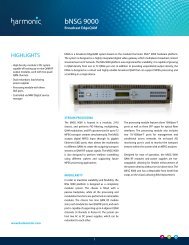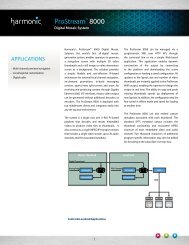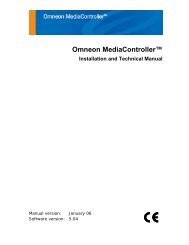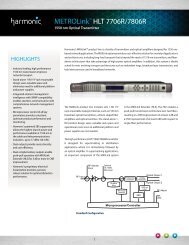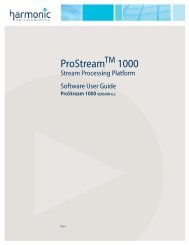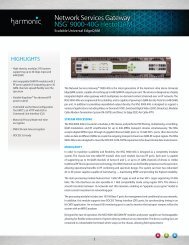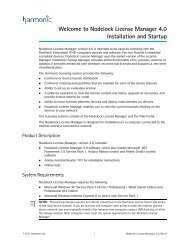NSG 9000-6G - Harmonic Inc
NSG 9000-6G - Harmonic Inc
NSG 9000-6G - Harmonic Inc
You also want an ePaper? Increase the reach of your titles
YUMPU automatically turns print PDFs into web optimized ePapers that Google loves.
Chapter 3 Configuring Platform Parameters<br />
Configuring SNMP and Syslog Parameters<br />
Main Board Part Number - The part number of the main board.<br />
Main Board Serial Number - The serial number of the main board.<br />
Main Board Storage Format - indicates whether a single or dual partition.<br />
Chassis Serial Number - The serial number of the chassis.<br />
4. To define device name, in Device Name (SysName), enter a name. The device name should<br />
allow easy identification of the device. Once you click Apply, the newly entered device<br />
name appears in the title bar. If you type in the title bar another name, once you click<br />
Apply it overrides the device name entered in Device Name box.<br />
NOTE: The Device Name is also required for the SNMP manager for defining the attributes of the<br />
SYSTEM MIB. See 3.5 Configuring SNMP and Syslog Parameters on page 28.<br />
5. In System Uptime, view the time the device is up and running since the last reboot.<br />
6. To set the GbE ports to support the IGMPv2 protocol only, select Force IGMP V2. <strong>NSG</strong><br />
<strong>9000</strong>-<strong>6G</strong> ignores any IGMPv3 messages and does not generate any IGMPv3 messages.<br />
3.5 Configuring SNMP and Syslog Parameters<br />
3.5.1 Configuring SNMP<br />
<strong>NSG</strong> <strong>9000</strong>-<strong>6G</strong> is capable of reporting its status via SNMP (Simple Network Management<br />
Protocol) to a third-party SNMP-based network management systems.<br />
<strong>NSG</strong> <strong>9000</strong>-<strong>6G</strong> status is reported to the SNMP manager in the following ways:<br />
• SNMP Traps - notifications that the <strong>NSG</strong> device initiates and sends to the SNMP manager<br />
to indicate the assertion or remittance of an alarm or warning. SNMP Traps are sent only<br />
to SNMP managers that are registered with the <strong>NSG</strong> <strong>9000</strong>-<strong>6G</strong>.<br />
• Alarms status queries - the SNMP manager may query the <strong>NSG</strong> for its current alarms<br />
status. The <strong>NSG</strong> reports this information using standard and custom SNMP MIBs.<br />
• Configuration and Traffic queries - the SNMP manager may query the <strong>NSG</strong> for various<br />
configuration parameters, as well as various traffic counters that indicate the rate of traffic<br />
that is flowing through the <strong>NSG</strong>'s interfaces.<br />
In addition, <strong>NSG</strong> <strong>9000</strong>-<strong>6G</strong> supports Syslog - a standard-based method for centralized logging<br />
of device messages. A Syslog server that is registered with the <strong>NSG</strong> <strong>9000</strong>-<strong>6G</strong> device will<br />
receive messages from the device whenever an alarm or warning is asserted or remitted.<br />
<br />
To set SNMP parameters<br />
1. Select the Platform tab.<br />
2. Select Chassis > SNMP & Syslog tab.<br />
Select to enable the<br />
row<br />
© 2012 <strong>Harmonic</strong> <strong>Inc</strong>. 28 <strong>NSG</strong> <strong>9000</strong>-<strong>6G</strong>, Version 2.7, Rev B



